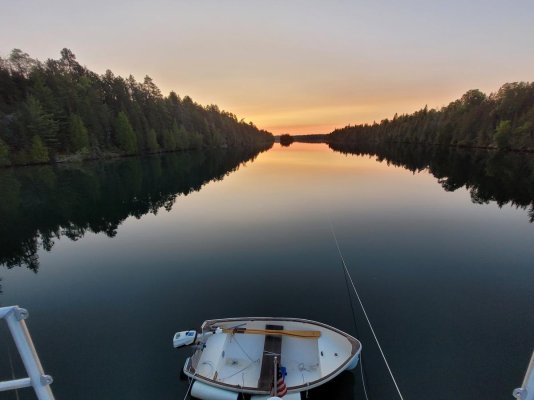klee wyck
Guru
- Joined
- Feb 8, 2014
- Messages
- 995
- Location
- USA
- Vessel Name
- Domino and Libra
- Vessel Make
- Malcom Tennant 20M and Noordzee Kotter 52
In lieu of stomping on Peter's thread (Weebles), I offer this comment here in response to his comment from the other thread.
Peter said:
"Stern anchor. Separate topic/thread as it's rare in the US except for those who anchor in tidal rivers. My current thinking is a smallish single piece anchor (vs a Danforth style) around 8kg with 2m of 1/4" chain and 150' of 1/2" braid all stored in an insulated shopping bag like Costco sells. Easy to store, easy to repack. I'd love a reel of webbing but they are dang expensive in the US, plus I don't have a great place to mount it though I suppose I could figure out something."
I share the sentiment above regarding stern anchors. I have come to think they are underappreciated and therefor under used for the conditions you are seeing. While I expect it is not as common in the Sea of Cortez where we are as it is in the mainland coastal roadsteads that you are experiencing, we have gotten tuned up a bit when winds fall off from swell.
The big cat is really comfortable in a good swell as long as the wind keeps her nosed into it. But it is common in the SOC for a northerly to run a few days creating a good swell on several hundred miles of fetch. That swell may take a couple of days to decay once the wind falls off and changes direction from onshore.
If the cat decides to straddle the swell under those conditions, my bunkmate gets really grouchy, and I get highly motivated as you might imagine.
The stern anchor is like magic under those conditions.
I have a Fortress with a section of chain hanging from it and the reel you see in the photo, which when combined with the use of the winch in the photo, leads to world peace.
The winch pulls the stern bar tight to the bow anchor in line with swell and all is well in my world.
Highly recommend this under the conditions you describe.
Peter said:
"Stern anchor. Separate topic/thread as it's rare in the US except for those who anchor in tidal rivers. My current thinking is a smallish single piece anchor (vs a Danforth style) around 8kg with 2m of 1/4" chain and 150' of 1/2" braid all stored in an insulated shopping bag like Costco sells. Easy to store, easy to repack. I'd love a reel of webbing but they are dang expensive in the US, plus I don't have a great place to mount it though I suppose I could figure out something."
I share the sentiment above regarding stern anchors. I have come to think they are underappreciated and therefor under used for the conditions you are seeing. While I expect it is not as common in the Sea of Cortez where we are as it is in the mainland coastal roadsteads that you are experiencing, we have gotten tuned up a bit when winds fall off from swell.
The big cat is really comfortable in a good swell as long as the wind keeps her nosed into it. But it is common in the SOC for a northerly to run a few days creating a good swell on several hundred miles of fetch. That swell may take a couple of days to decay once the wind falls off and changes direction from onshore.
If the cat decides to straddle the swell under those conditions, my bunkmate gets really grouchy, and I get highly motivated as you might imagine.
The stern anchor is like magic under those conditions.
I have a Fortress with a section of chain hanging from it and the reel you see in the photo, which when combined with the use of the winch in the photo, leads to world peace.
The winch pulls the stern bar tight to the bow anchor in line with swell and all is well in my world.
Highly recommend this under the conditions you describe.



